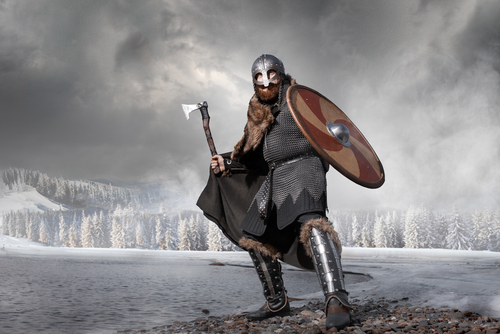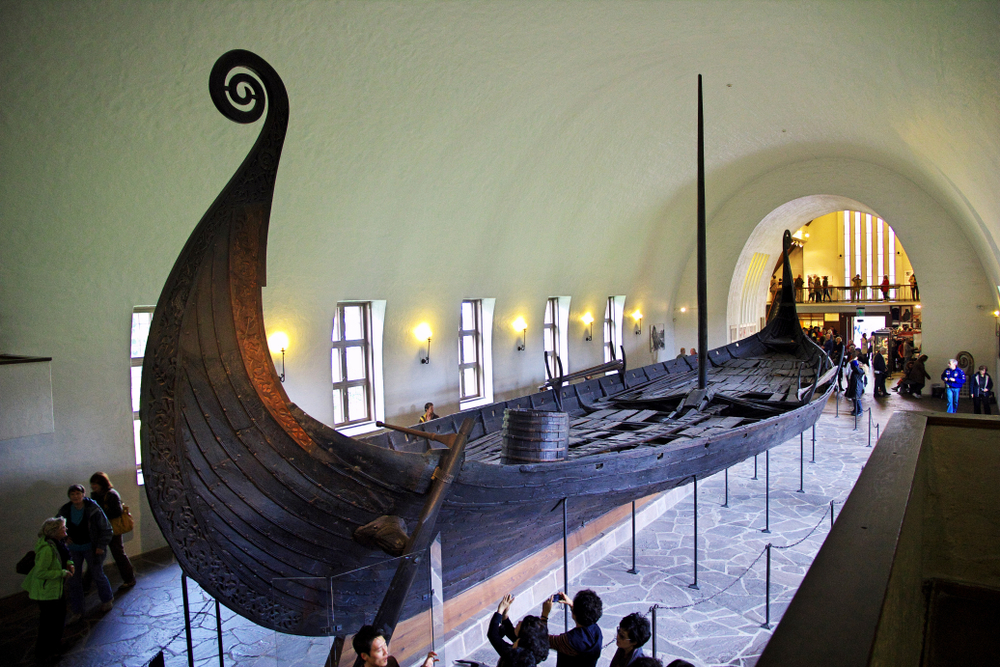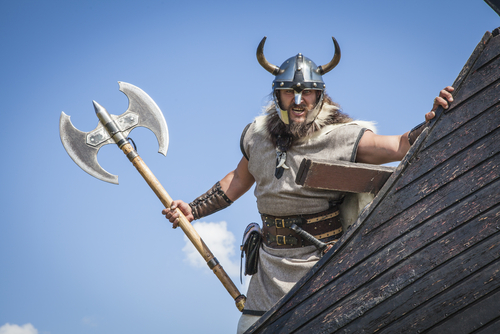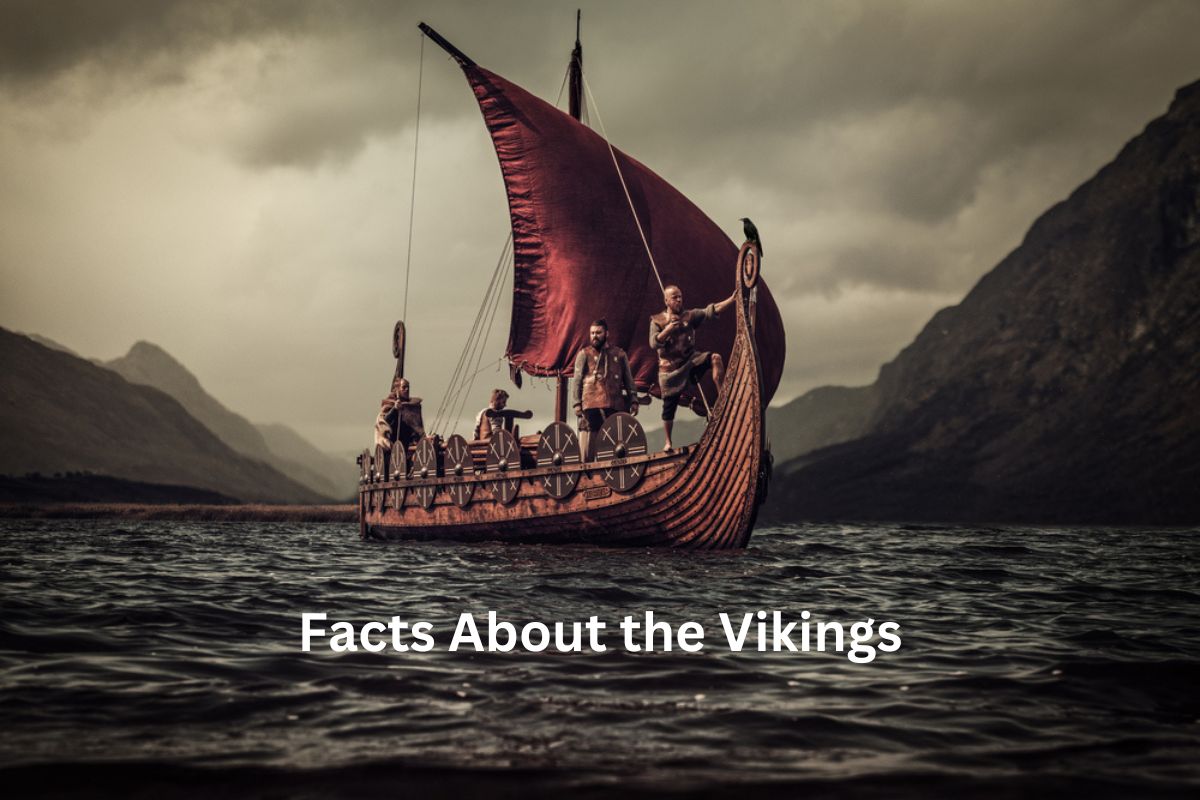The Vikings were seafaring people from Scandinavia (modern-day Denmark, Norway, and Sweden) who lived during the Viking Age, roughly from the late 8th century to the early 11th century.
They were known for their skilled shipbuilding, daring exploration, and raids on distant lands. The Vikings had a complex society with a rich cultural heritage, including Norse mythology and runic writing.
Their legacy can be seen in the lasting impact they had on language, art, and the cultures of the regions they encountered. The Vikings continue to be a subject of fascination and study, inspiring numerous works of literature, film, and historical research.
Vikings Facts
1. Originated from Denmark, Norway, and Sweden
The Vikings, often referred to as Norsemen, hailed from the Scandinavian countries of Denmark, Norway, and Sweden.
These regions, with their rugged landscapes, fjords, and proximity to the North Sea and the Atlantic Ocean, played a crucial role in shaping the Viking way of life.
Also Read: Viking History Timeline
The Vikings were diverse in terms of their origins, and not all Vikings were of the same ethnic background. They came from various tribes and clans within these regions.

2. Viking Age lasted from the late 8th to the early 11th century
The Viking Age is a historical period that is generally considered to have begun with the raid on the Lindisfarne monastery in England in the year 793.
Also Read: Facts About Viking Longships
This event marked the first recorded Viking raid on foreign soil. The Viking Age continued for several centuries, with the Norman conquest of England in 1066 marking its traditional end.
During this era, the Vikings undertook extensive voyages, raids, and exploration, leaving a significant impact on the regions they encountered.
3. Known for exploration, including reaching North America
Vikings were renowned for their seafaring skills and daring exploration. One of the most remarkable feats was their discovery of North America, which they referred to as “Vinland.”
Around the year 1000 AD, Norse explorer Leif Erikson is believed to have led an expedition to what is now Newfoundland, Canada. This makes the Vikings among the earliest Europeans to set foot in North America, several centuries before Christopher Columbus.
The exact extent of their exploration in North America is still a subject of archaeological research and debate, but it demonstrates their remarkable navigational abilities and their willingness to venture into the unknown.
4. Built iconic longships for their voyages
Vikings were renowned shipbuilders, and their expertise in this field was a key factor in their success as seafarers and explorers. They crafted two main types of ships: longships (langskip) and knarrs.
- Longships: These were swift and slender vessels designed for both war and exploration. Longships were equipped with oars and a single mast with a square sail, which allowed them to navigate shallow rivers and open seas. Their shallow draft made them ideal for surprise raids.
- Knarrs: Knarrs were broader and sturdier, primarily used for cargo transport and trade. They could carry a significant amount of goods, enabling the Vikings to establish trading networks across Europe and beyond.
The advanced ship designs allowed the Vikings to venture as far as North America, the Mediterranean, and even the Caspian Sea.

5. Engaged in raids and warfare
While not all Vikings were warriors, their reputation for raiding and warfare is one of their defining characteristics. Viking raids, often depicted as violent and ruthless, targeted monasteries, towns, and coastal settlements.
These raids were not only motivated by the pursuit of wealth but also by the desire for adventure and glory. Viking warriors were known as “berserkers,” and they sometimes wore distinctive clothing and armor.
- Tactics: Viking warriors were skilled in using axes, swords, spears, and bows. They also utilized tactics like hit-and-run attacks, surprise ambushes, and siege warfare.
- Conquests: Vikings established settlements in various regions, such as the Danelaw in England and Normandy in France. They even founded the city of Dublin in Ireland.
6. Practiced Norse mythology and some converted to Christianity
The Vikings practiced Norse paganism, a polytheistic religion centered around gods and goddesses from Norse mythology.
Some well-known deities include Odin (the Allfather), Thor (the Thunder God), Freyja (the Goddess of Love), and Loki (the Trickster).
They believed in an afterlife that included Valhalla, a warrior’s paradise for those who died in battle.
- Rituals: Viking religious rituals included sacrifices and offerings to appease the gods, as well as the use of sacred symbols like the hammer of Thor (Mjölnir) and the tree of life (Yggdrasil). They also held blóts, ceremonies involving animal sacrifices.
- Conversion to Christianity: Over time, as the Vikings encountered Christian communities through their raids and trade, some of them converted to Christianity. This religious shift had a profound impact on their culture and society.
7. Used a runic writing system
The Vikings had their own writing system known as runes. Runic inscriptions can be found on various artifacts, including runestones, amulets, weapons, and even personal items like combs. Some key points about runes:
- Alphabet: The runic alphabet, known as the “futhark” (named after the first six runes: F, U, Th, A, R, and K), consisted of a set of angular characters. It was primarily used for short inscriptions, often memorializing individuals or events.
- Mystical Beliefs: Runes held a mystical significance in Viking culture. They were believed to possess magical properties and were used for divination and protective purposes.
- Regional Variation: Different regions of Scandinavia had their own runic variants, leading to a range of runic alphabets with varying characters and meanings.

8. Society had kings, nobles, freemen, and slaves
Viking society was organized into distinct social classes, and one’s social status was usually hereditary. Here are the key social classes:
- Kings (Konungr): The highest social class, kings ruled over entire regions or kingdoms. They had authority over laws and governance.
- Jarls (Nobles): Jarls were the aristocracy, holding significant land and power. They often served as regional leaders or lords under the king.
- Karls (Freemen): The freemen constituted the middle class. They were landowners, farmers, traders, and craftsmen. Freemen had certain legal rights and were expected to serve in the local Thing (assembly).
- Thralls (Slaves): Thralls were at the bottom of the social hierarchy. They were typically prisoners of war or people who fell into debt bondage. Thralls had few rights and were considered property.
Social mobility between classes was limited, but it was possible for individuals to improve their status through acts of bravery, accumulation of wealth, or marriage into higher classes.
9. Viking women had more rights compared to some societies
Viking women had more rights and freedoms compared to many other contemporary societies. Here are some key aspects of women’s roles in Viking society:
- Property Rights: Viking women could own property, inherit land, and engage in trade. This gave them a level of economic independence and influence.
- Participation in Warfare: While not common, some Viking women did participate in warfare, particularly in defensive roles when their communities were under threat. The legendary Viking warrior Lagertha is a notable example.
- Legal Rights: Women had legal rights, and they could take part in legal proceedings, such as the Thing, to voice their opinions and seek justice.
- Domestic and Farming Roles: In addition to their economic and legal activities, many Viking women played crucial roles in managing households, farms, and raising children.
The status of women in Viking society varied somewhat depending on the region and time period, but overall, they had more autonomy and agency compared to some other societies of the era.
10. Produced intricate metalwork and art
The Vikings were skilled craftsmen and artists, leaving behind a rich legacy of art and craftsmanship. Here are some key aspects of their artistic achievements:
- Metalwork: Viking craftsmen created intricate metalwork, including jewelry, brooches, and weaponry. They used materials such as gold, silver, bronze, and iron to fashion these items, often adorned with intricate designs and motifs from Norse mythology.
- Woodcarvings: Wooden objects, such as furniture and religious artifacts, featured detailed carvings and intricate patterns. The famous Oseberg Ship burial, for example, contained well-preserved wood carvings.
- Textiles: Viking textiles were known for their quality, and they often incorporated complex patterns and colorful dyes. Clothing and tapestries were important aspects of Viking art.
- Runestones: Many runestones, erected as memorials or markers, featured both runic inscriptions and images, providing valuable insights into Viking art and culture.
11. Influenced the English language with many words
The Vikings had a lasting impact on the English language and contributed to its vocabulary in various ways:
- Loanwords: Many Old Norse words found their way into Old English, enriching the language with new terms. For example, words like “sky,” “egg,” “knife,” and “window” have Old Norse origins.
- Place Names: Viking settlers in regions like the Danelaw in England left their mark on local place names. For instance, names ending in “-by” (meaning “village” in Old Norse) are common in England.
- Pronunciation: Viking influence also affected English pronunciation and grammar, contributing to the development of the language.
12. Had their own legal codes and assemblies
The Vikings had their own legal codes and systems of governance. Key elements of their legal system include:
- Thing: The Thing was a central assembly where free men would gather to discuss and settle disputes, make laws, and conduct legal proceedings. Each region had its own Thing.
- Law Codes: Different regions had their own legal codes, such as the Gulating in Norway and the Grágás in Iceland. These codes outlined various laws and penalties for different offenses.
- Ordeal: Viking legal proceedings sometimes involved ordeals, where the accused would undergo a physical test, often with a religious or supernatural element, to prove their innocence or guilt.
13. Left a lasting cultural legacy in Scandinavia and beyond
The Vikings’ legacy is still evident in many aspects of modern culture and history:
- Scandinavian Culture: The cultural heritage of the Viking Age continues to shape the modern Scandinavian countries of Denmark, Norway, and Sweden. Norse mythology, folklore, and traditions are still celebrated.
- Normandy and England: Viking influence is evident in the Normans, who were descended from Viking settlers in Normandy, France. The Norman Conquest of England in 1066 led to significant changes in English culture and governance.
- Literature and Pop Culture: Viking sagas and legends have inspired a wealth of literature, from medieval Icelandic sagas to modern novels. Vikings have also been popularized in contemporary pop culture through books, TV series, and movies.
- Exploration: The Vikings’ spirit of exploration and adventure left an enduring mark on the history of exploration, influencing future generations of explorers and navigators.
The Vikings’ contributions to art, language, law, and culture have left a lasting legacy that continues to captivate and inspire people around the world.
